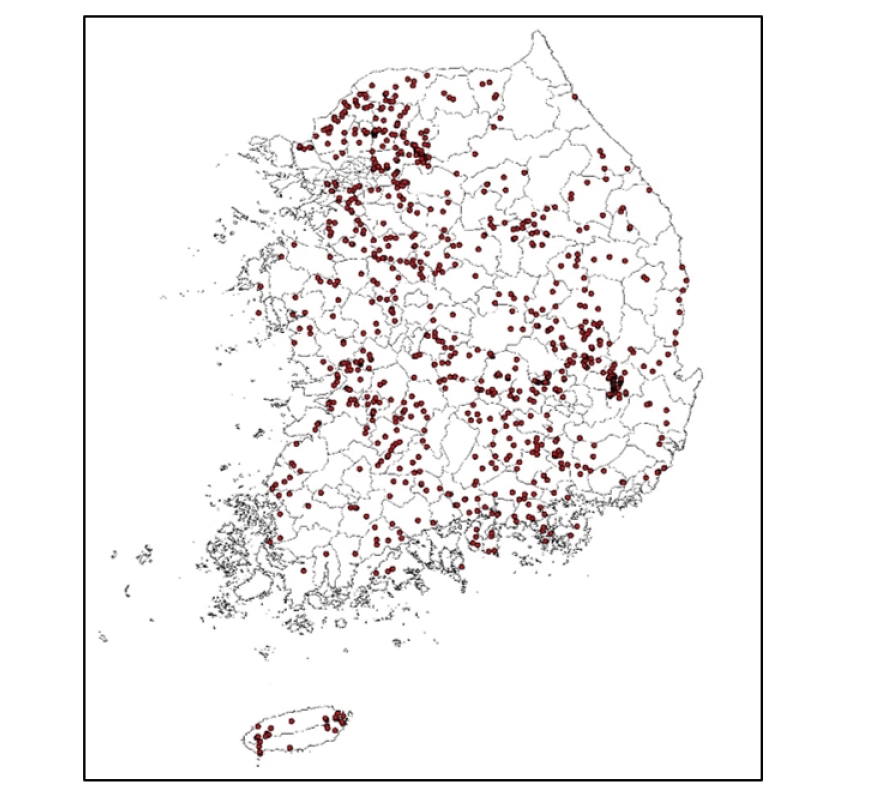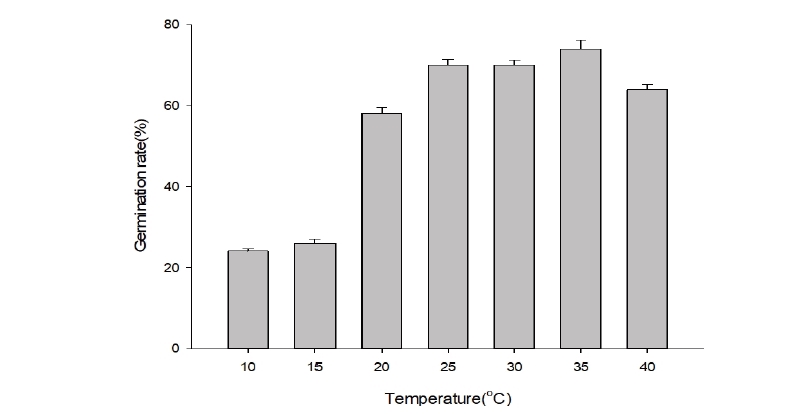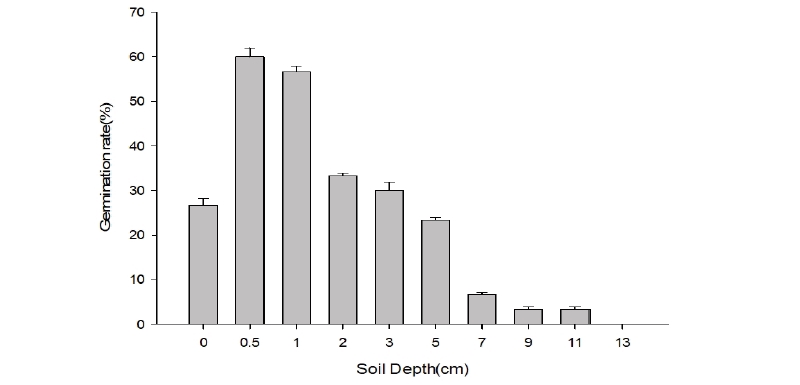서 언
온대에서 열대까지 폭넓게 분포하는 비름(Amaranthus)속 식물은 전세계적으로 70여종이 분포하고 있고 많은 잡종화가 이루어져 분류가 어려운 식물 중에 하나이다(Judd et al., 2008). 국내에 분포하고 있는 비름속 식물은 모두 외래식물로 농경지에 9여종이 유입되어 있다. 농경지와 주변에서 분포를 확인할 수 있는 비름속 잡초는 청비름, 개비름, 가시비름, 털비름, 가는털비름, 민털비름, 긴털비름 등이 있다(Park, 2009). 가는털비름(Amaranths patulus Bertol.)은 일년생 초본으로 남아메리카 원산이며 거의 전국에 분포하고 있다. 잎은 어긋나며 식물의 높이는 60-200 cm로 곧게 자라며 농경지 주변이나 농경지에 많이 유입되는 외래잡초이다(Park, 2009). 농경지 외래잡초의 확산은 작물의 재배와 관리에 많은 경제적 어려움을 주고 있다(David et al., 2004). 외래잡초는 의도적, 비의도적으로 다양한 침입경로를 통해 교란이 빈번한 도로, 농경지, 목장 등의 경로로 빠르게 분포영역이 확장되고 있으며 환경조건에 대한 강한 내성을 가지고 있는 것이 특징이다(Gould, 1991; Jordan and Jannink, 1997; Martinez-Ghersa et al., 2000; Mohler, 2001). 인간의 영농활동이나 개발과 같은 토지이용의 반복적인 변화는 생태계의 변화를 가져와 외래잡초가 서식할 수 있는 공간을 제공한다(Hong et al., 2005). 국내 농경지에 분포하는 외래잡초는 2005년에는 19과 100종에서 2015년에는 28과 166종으로 외래잡초 분포가 점차 확대되고 있는 것으로 보고되어 있다(Lee et al., 2006).
농경지에 분포하고 있는 외래잡초 방제기술 개발에 관한 연구는 애기수영의 종자와 지하경의 번식 특성을 구명하고 경엽처리 제초제인 MCPP액제와 dicamba 액제에 대한 애기수영의 방제 효과를 보고하였고(Kim et al., 2001), 목초지에 발생하는 가시박과 가시비름의 확산을 저지하고 효율적으로 관리하기 위하여 제초제를 선발하였다(Lee et al., 2007). 가는털비름의 생태형에 관한 연구에서는 유사종과의 구별 방법과 유묘의 형질을 비교하여 어린 잡초일 때 구분이 가능하다고 연구된 바 있다(Oh et al., 2005).
본 연구는 농경지에 폭넓게 확산되어 있는 외래잡초 가는털비름의 분포 및 발아생태와 콩재배지에서의 경합 및 방제 약제를 선발하기 위해 수행되었다.
재료 및 방법
분포조사
가는털비름의 분포조사는 2018년 3월부터 10월까지 전국 농경지를 대상으로 실시하였다. 또한 농촌진흥청(Lee et al., 2006)에서 조사된 자료와 국립생태원(2017, 미발표)에서 조사된 자료를 포함하여 전국의 분포지점에 대해 GIS 프로그램(Esri, California, USA)을 이용하여 지점을 표시하였다.
발생 생태 조사
가는털비름의 종자를 2017년에 수집하여 정선한 다음 종이봉지에 넣고 4℃ 냉장상태에 보관하였다. 발아실험을 위해 직경 9.5 cm Petri-dish에 여과지를 1매 깔고 증유수를 15 mL 분주한 다음 정선된 종자를 100립씩 3반복 치상하였다. 가는털비름의 정온조건에서의 발아율을 확인하기 위해 10-40℃까지 5℃ 간격으로 조사하였고, 변온조건에서의 발아율을 확인하기 위해 밤/낮의 온도조건으로 10/15, 15/20, 20/25, 25/30, 30/35, 35/40℃를 설정하여 발아율을 확인하였다. 토심별 발아양상을 확인하기 위해 포트에 종자의 파종 심도를 0, 0.5, 1, 2, 3, 5, 7, 9, 11, 13 cm로 유지하여 발아율을 측정하였다.
가는털비름과 콩의 밀도별 경합
가는털비름과 콩과의 경합관계를 조사하기 위해 포장에서 1 m × 1 m 조사구를 3반복으로 임의배치하여 가는털비름 밀도별 콩의 수량을 예측하였다. 가는털비름의 밀도는 조사구당 0, 8, 16, 32개체를 이식하였고 콩은 조사구당 9개체를 심어서 경합의 영향을 분석하였다. 시기별 콩의 초장, 생체중, 분지수, 백립중, 등숙률 등을 조사하였고 가는털비름의 밀도별 콩의 수량을 분석하였다.
가는털비름의 방제 실험은 직사각형의 18 cm×23 cm 포트에 가는털비름 종자 10립씩 파종하여 실험하였다. 토양처리 제초제의 방제효과를 확인하기 위해 metolachlor (3 kg 10 a-1), alachlor (3 kg 10 a-1), trifluralin (200 mL 10 a-1), 1 - 3엽기의 방제효과를 검토하기 위해 경엽처리제 bentazone (300 mL 10 a-1), glyphosate-potassium (200 mL 10 a-1), triclopyr-TEA (500 mL 10 a-1)를 처리하여 방제효과를 달관조사로 분석하였다.
결과 및 고찰
가는털비름 분포현황
가는털비름의 분포조사 결과 868지점에서 출현하는 것으로 확인되었다. 분포지역은 산림지역외에 거의 국내 모든 지역에 분포하고 있었다(Fig. 1.) 서식공간은 대부분 농경지와 농경지 주변부, 하천변, 도로변, 나출지 등 다양한 장소에서 발견되었다. 2002년도에 전국적으로 145지점에 분포하고 있는 것으로 보고된 자료에 비해 분포면적이 많이 확장된 것으로 조사되었고 전라북도, 충청북도, 강원도 등에서 분포지역이 확인된 것으로 분석되었다(Park, 2009).
온도 및 토심별 발생 특성
가는털비름의 온도별 발아율을 비교해 본 결과 정온조건에서 35℃는 74%, 25℃와 30℃는 70%의 발아율을 보였고(Fig. 2.), 변온조건에서 25/30, 30/35℃에서 82%와 84%의 발아율을 나타내는 것으로 조사되었다(Fig. 3.) 토심별 가는털비름의 발아율은 0.5 cm으로 파종했을 때 60%의 가장 높은 발아율을 보였고, 1 cm에서 57% 비교적 높은 발아율을 보였다(Fig. 4.). 같은 비름속 잡초 중에 제주도에만 분포하는 가시비름은 30, 35℃에서 높은 발아율을 보였고 25/30℃에서 가장 왕성한 생육을 보여 가는털비름과 같이 남방계 잡초인 비름속의 특성을 잘 보여주고 있는 것으로 판단되었다(Oh et al., 2008).
가는털비름과 콩의 밀도별 경합
포장에서 가는털비름을 대조구(0개체), 8, 16, 32개체를 파종하여 콩의 길이, 생체중, 수량을 비교하였을 때 가는털비름의 밀도가 높아질수록 콩의 길이와 생체중은 감소하였다(Table 1). 콩의 수량변화도 개체당 분지수, 백립중, 등숙률, 수량 및 수량지수도 가는털비름의 밀도가 높아질수록 개체당 분지수가 감소하고 백립중과 등숙률도 감소하였다. 또한 수량과 수량지수도 대조구에서 비해 급격하게 감소하였는데, 가는털비름이 32본 출현한 포장에서는 약 98.5%의 수량감소를 보였다(Table 2). 이는 가는털비름의 초기 성장이 왕성하여 작물에 비해 빠르게 우위를 선점하였고 반면 콩의 성장은 늦어지고 제한되는 영향을 미치는 것으로 분석되었다. 가는털비름이 농경지 주변이나 하천변에 관찰되었을 때는 1-1.5 m 정도의 식물 높이를 가지고 있지만 포장내 조건에서는 시비의 영향으로 2-3 m 높이로 성장하여 콩의 성장에 영향을 많이 미친 것으로 분석되었다. 가는털비름과 친환경 고추와의 경합에서도 가는털비름에 의해 고추의 수량이 대조구에 비해 72.6% 감소하는 것으로 조사되어 가는털비름의 경작지내 발생은 작물의 수량에 크게 영향을 미치는 것으로 판단되었다(Won et al., 2012).
|
Table 2. Yield and yield components of soybean as affected by different densities ofAmarnthus patulus 
|
|
zMean separation within columns by Duncan’s multiple range test at P =0.05 level. |
가는털비름과 방제 효과
가는털비름의 포트내 토양처리제 방제 효과는 metolachlor, alachlor를 처리했을 때 100% 방제효과가 나타나는 것으로 확인되었고 trifluralin은 약 80%정도 효과를 보이는 것으로 나타났다(Table 3). 비름속 식물은 제초제 저항성이 나타나는 것으로 보고되어 있는데 프로토포르피리노겐 옥시다아제(Protoporphyrinogen oxidase) 억제제에 대한 비름속 식물의 제초제 저항성에는 metolachlor와 혼합하여 방제하는 것이 효과적이라고 알려져 있다(Varanasi et al. 2018).
가는털비름이 2-3엽기 정도 성장했을 때 경엽처리제의 방제효과는 triclopyr-TEA를 처리했을 때 15일 이후에 100% 방제가 되었고 glyphosate-potassium과 bentazone은 15일 이후에 각각 97, 90% 방제가 되는 것으로 확인되었다(Table 4). glyphosate는 비름속 식물에 제초제 저항성이 있을 수도 있어 제한적인 방제에 활용할 수 있을 것으로 판단되었다(Culpepper, 2006).
Authors Information
Yong Ho Lee, https://orcid.org/0000-0002-8714-3746
Soo In Sohn, https://orcid.org/0000-0001-8819-7247
Sun Hee Hong, https://orcid.org/0000-0001-7581-0604
Chang Seok Kim, National institute of crop science, Higland agriculture research institute, Researcher(Ph.D)
Chae Sun Na, https://orcid.org/0000-0002-7936-2121
Young Ju Oh, https://orcid.org/0000-0001-8861-8558









